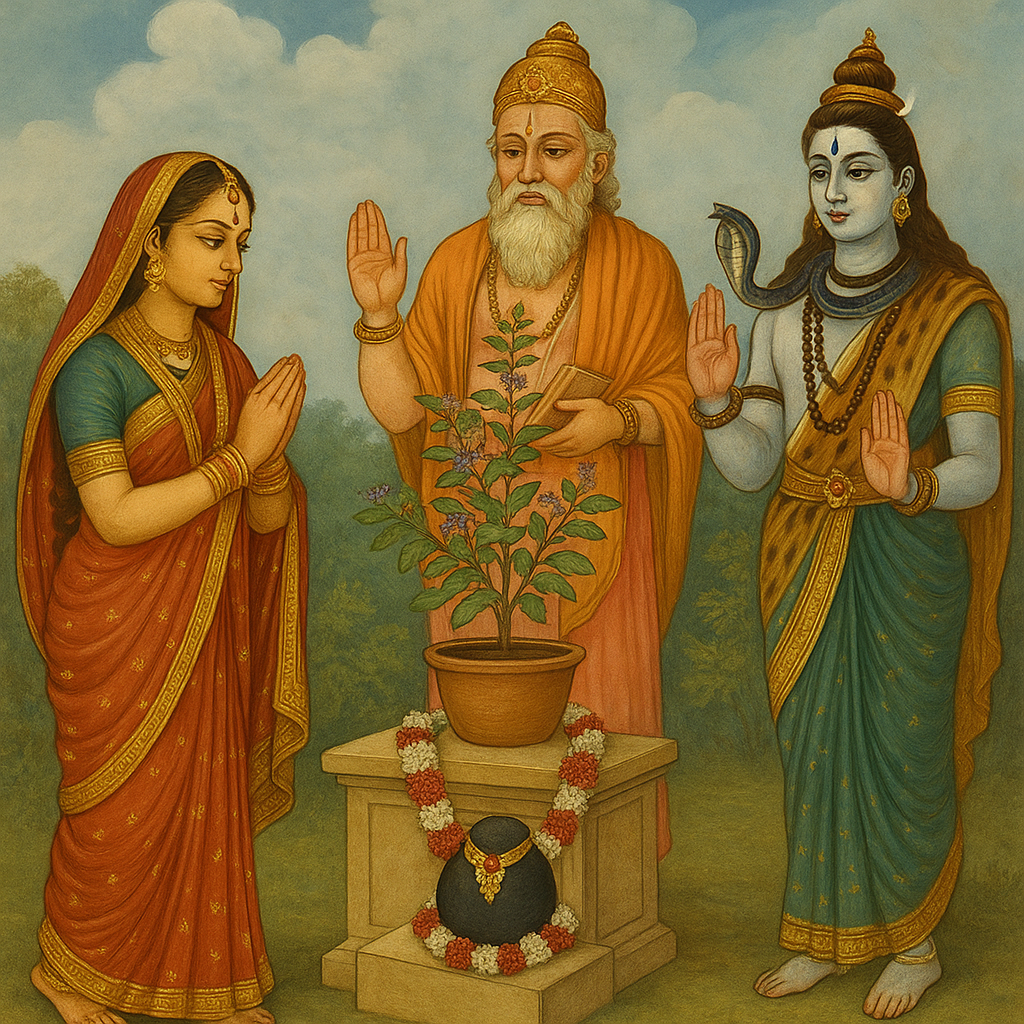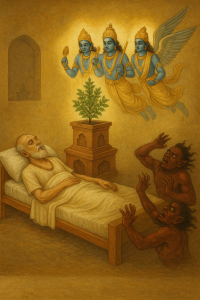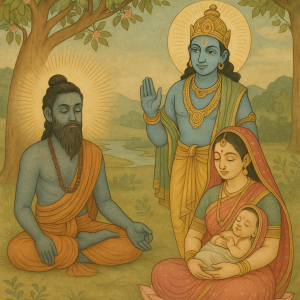The Divine Transformation
After Lord Viṣṇu accepted Tulasī’s curse and revealed His divine form, Tulasī Devī’s body transformed. Her gross body fell to the earth, but from her subtle form, a sacred plant emerged—the plant now revered as Tulasī in every Vaiṣṇava home and temple.
The sacred plant bore green leaves and fragrant blossoms, symbolizing purity, surrender, and unbreakable devotion. Her presence sanctified the earth. Rivers, gardens, and temples became auspicious wherever she grew. It was declared that no offering to Lord Viṣṇu or Kṛṣṇa would be complete without her leaves.
From that moment forward, Tulasī became the holiest of all plants, the empress of devotion, and the foremost among women in purity and chastity.
The Śālagrāma-śilā Appears
In accordance with her curse, Lord Viṣṇu manifested as a sacred stone form—the Śālagrāma-śilā, a black, round stone found only in the Gāṇḍakī River in Nepal.
This form of the Lord is non-different from His eternal self, and He declared that this form would be worshiped in temples, homes, and hearts for all time. The Śālagrāma-śilā became the living deity of Lord Nārāyaṇa—silent, motionless, but full of unlimited mercy and potency.
Wherever He would be worshiped, Tulasī’s leaves must accompany the offering.
The Divine Marriage Ceremony
To commemorate their eternal union, the marriage of Tulasī and the Śālagrāma-śilā was arranged by the demigods, sages, and devotees.
A divine wedding ceremony took place—celebrated by the rivers, trees, clouds, sages, Gandharvas, and Apsarās. Lord Brahmā officiated, and Lord Śiva and Goddess Pārvatī came to bless the marriage.
Tulasī was bathed, dressed in beautiful silks, and adorned with golden ornaments and sandalwood paste. Śālagrāma-śilā was bathed and decorated with garlands. In a celestial voice, the wedding mantras were chanted, and the sacred union was declared eternal.
From that day, it was established in the scriptures that the marriage of Tulasī and Śālagrāma would be celebrated by devotees every year, especially on the Tulasī Vivāha festival in the month of Kārttika.
Their union was not material but spiritual—a symbol of the eternal bond between the devotee and the Lord, the bhakta and Bhagavān.
The Glories of Worshiping Tulasī and Śālagrāma
It is said in the Padma Purāṇa and Skanda Purāṇa that whoever worships Śālagrāma with Tulasī leaves obtains the fruit of performing thousands of yajñas, bathing in all holy rivers, and visiting all tīrthas.
Tulasī is described as non-different from Rādhārāṇī, and Śālagrāma as non-different from Śrī Kṛṣṇa. The worship of both is the essence of pure bhakti.
Even the demigods long to attain the dust from Tulasī’s feet. She is the purifier of sins, the destroyer of offenses, and the carrier of devotion to the Lord’s lotus feet.
Thus ended the earthly pastimes of Tulasī and Śaṅkhacūḍa—but their glories live forever in the hearts and altars of devotees.
Lessons to Be Learned
1. The Lord Always Honors His Devotee’s Surrender
Tulasī Devī was deceived, cursed, and wept—but ultimately, the Lord fulfilled her deepest desire: to be united with Him eternally. Śrīla Prabhupāda emphasized that Kṛṣṇa never forgets even a single act of sincere devotion.
“Even if one falls down, if he is sincerely chanting and serving, Kṛṣṇa will take care of him.” – Śrīla Prabhupāda
2. Bhakti Is Immortalized Through Ritual and Symbol
The Tulasī-Vivāha is not merely a ceremony—it is a spiritual celebration of the love between the devotee and God. It reminds us that every act of love and service is remembered, honored, and reciprocated eternally by the Lord.
3. The External Form May Perish, But Devotion Never Dies
Though Tulasī’s material body fell, she reappeared as a sacred plant—worshiped by all. This teaches that real identity lies not in the body, but in devotion. The bhakti we cultivate is eternal and indestructible.
4. The Marriage of the Soul and God Is the Goal of Life
The union of Tulasī and Śālagrāma symbolizes the eternal goal of bhakti—to be wedded in love and service to the Supreme Lord. This is the ultimate success for every living being.
5. Tulasī and Śālagrāma Are the Gateway to Pure Devotion
Śrīla Prabhupāda instructed that every Vaiṣṇava home should worship Tulasī and offer her leaves to the Lord. He emphasized:
“Wherever Tulasī is worshiped, that place becomes a tīrtha. She brings all auspiciousness.”
6. Devotion Transforms All Suffering Into Glory
Tulasī’s trials—her curse, deception, and heartbreak—became the cause of her eternal glory. In the same way, a devotee accepts every difficulty as Kṛṣṇa’s arrangement, knowing it leads to purification and eternal service.



